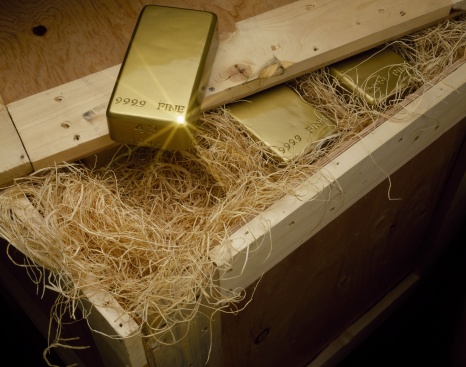Gold prices may have tumbled in 2013, but gold has tried to make a significant recovery at the start of 2014. New data from the World Gold Council show that 2013 was a year in which total demand was down 15%, when you include the effect of exchange traded fund (ETF) outflows. Still, 2013 was a strong year, in terms of physical demand from buyers of gold bars, coins and jewelry, and also from the highly important central bank buyers.
Of the total 3,756.1 gold tonnes bought globally in 2013, some 368.6 tonnes came from central banks. Last year even marked the fourth consecutive one of net central bank demand.
24/7 Wall St. reviewed the top 40 nations and governmental holders of the world’s gold to see who is driving demand. Central banks can be considered the most important buyers of gold of all groups because they generally buy gold to hold against their foreign reserves for years. Because of their size and scale, central banks can simply make the largest single purchases (or sales) of gold, compared to any other single group.
It turned out that just seven of the top 40 nations holding gold added to their central bank holdings. Still, these seven nations accounted for more than 293 tonnes of the 368.6 tonnes purchased from all central banks measured by the World Gold Council.
Consumers in China and India may have led the total world gold demand in 2013, signaling a demand shift from West to East, but the central bank gold holdings of China and India were not shown to have changed at all from 2012. The central bank of Azerbaijan bought 20 tonnes of gold in 2013, but it was not included in this analysis because it was that nation’s first significant purchase, and it ranked all the way down in 62nd place among central bank gold holders.
The World Gold Council said that the pace of central bank gold buying slowed towards the end of 2013, due to the heightened volatility of gold and a slower rate of foreign reserve accumulation. The total central bank demand in 2013 may seem weak with a 32% drop in net tonnes purchased, but you have to keep in mind that 2012 was the strongest year of central bank gold buying in nearly 50 years.
This year has begun very differently from 2013. European risks are far lower than they were a year ago. The five PIIGS — the economically fragile eurozone nations of Portugal, Italy, Ireland, Greece and Spain — and even other European nations did not turn out to be sellers of gold, even with the Central Bank Gold Agreement in place for European central banks to sell gold.
With many emerging market nations experiencing currency shocks at the start of 2014, this sets the stage for potentially more gold demand to act as a stabilizer for the world’s emerging economies.
What really stood out in the World Gold Council annual report for 2013 is the observance of central banks as one category where there “remains little appetite from signatories to reduce their gold holdings any further.” These are the seven nations that make up the world’s largest gold holders and that keep adding gold into their central bank holdings.
1. Russia
> 2013 gold reserves: 1,035.2 tonnes
> 2012 gold reserves: 957.8 tonnes
> Pct. of total foreign reserves 2013: 8%
> Pct. of total foreign reserves 2012: 9%
> GDP: $2.486 trillion (7th highest)
> Population: 142.5 million
Russia’s central bank is again listed as the eighth largest gold holder in the world. The bank added a whopping 77.4 tonnes last year to the 851.5 tonnes it held as of two years ago. Russia is a major gold producing nation. It is also no secret the country wants to further increase its prominence in the global economy. Russia’s gold appetite seems to be neither price-driven nor price-sensitive, so it seems reasonable to expect the country to continue its current pace of gold buying.
2. Turkey
> 2013 gold reserves: 519.7 tonnes
> 2012 gold reserves: 359.6 tonnes
> Pct. of total foreign reserves 2013: 15%
> Pct. of total foreign reserves 2012: 16%
> GDP: $1.11 trillion (17th highest)
> Population: 80.7 million
Turkey’s central bank now ranks as the 12th-largest holder of gold, up from 16th a year ago, despite being a relatively new entrant to the list of nations with the most gold. That additional gold came to 160.1 tonnes last year, for a whopping gain of more than 44% in total gold. Turkey’s gold accumulation is largely tied to the country’s changes in its banking regulations. The changes, which begun several years ago, allow the central bank to accept gold as reserve requirements from commercial banks. The nation’s recent currency shock arguably may create a need for more gold ownership ahead. The central bank recently jacked up interest rates to stave off inflation and to protect the Turkish lira. In 2012, Turkey added a net of 164.5 tonnes of gold to its reserves.
3. Venezuela
> 2013 gold reserves: 367.6 tonnes
> 2012 gold reserves: 365.8 tonnes
> Pct. of total foreign reserves 2013: 72%
> Pct. of total foreign reserves 2012: 75%
> GDP: $397.7 billion (34th highest)
> Population: 28.46 million
Venezuela added gold over the past year, but only about 1.8 tonnes. Because it added such a small amount, Venezuela dropped one spot, becoming the 16th largest central bank owner of gold — passed up by Turkey in the past year. Venezuela has been facing a currency crisis, and one way it can fend off pressure on its bolivar is to own more gold. About 70% of the nation’s foreign reserves were in gold last year — part of a policy by the late Venezuelan President Hugo Chavez to move away from what he called the “dictatorship of the dollar.” Unfortunately, even in the post-Chavez era, Venezuela still has a black market for its currency.
4. The Philippines
> 2013 gold reserves: 193.2 tonnes
> 2012 gold reserves: 192.7 tonnes
> Pct. of total foreign reserves 2013: 9%
> Pct. of total foreign reserves 2012: 12%
> GDP: $419.6 billion (32nd highest)
> Population: 105.7 million
The Philippines, which added just one-half tonne of gold last year, kept its rank as the 23rd-largest central bank holding of gold. The nation has suffered after the 2013 cyclone that ravaged much of the country. Thousands died, over a million homes were destroyed or damaged, and some 4 million people were reportedly displaced. Without that disaster, the central bank gold-buying might have been higher. Gold was 9% of the nation’s reserves for 2013, down from 12% a year earlier.
5. Kazakhstan
> 2013 gold reserves: 143.7 tonnes
> 2012 gold reserves: 115.0 tonnes
> Pct. of total foreign reserves 2013: 23%
> Pct. of total foreign reserves 2012: 22%
> GDP: $228.7 billion (54th highest)
> Population: 17.7million
Kazakhstan may not be a major economy by most measurements, but the World Gold Council noted the country was actively adding gold reserves to its central bank. The Central Asian nation was ranked the 26th-largest central bank holder of gold last year, up from 30th at the end of 2012. Still, its total percentage of foreign reserves grew only about one point to 23%. Kazakhstan has been adding gold via purchases and swaps, making it one of the stronger adding nations, considering its size. The 28.7 tonnes it added in the past year increased the central bank’s total holdings by 25%. Those gold reserves are also seen as a counterbalance to economic pressures on reserve currencies such as the euro or the U.S. dollar.
6. South Korea
> 2013 gold reserves: 104.4 tonnes
> 2012 gold reserves: 84.4 tonnes
> Pct. of total foreign reserves 2013: 1%
> Pct. of total foreign reserves 2012: 1%
> GDP: $1.59 trillion (13th highest)
> Population: 48.95 million
South Korea maintained its ranking as the 34th-largest central bank holder of gold in 2013. The 20 tonnes added last year was identical to the 20 tonnes added in 2012. However, gold reportedly accounted for only about 1% of the nation’s foreign reserves. Reports late last year, meanwhile, said North Korea was selling large amounts of gold to China to stave off economic collapse. It seems possible the continued turmoil in North Korea could have something to do with South Korea adding gold. Regardless of the reason, the Korean central bank likely has decided having the 13th-largest economy may need more than just 1% of its foreign reserves as hard assets.
7. Indonesia
> 2013 gold reserves: 78.1 tonnes
> 2012 gold reserves: 73.1 tonnes
> Pct. of total foreign reserves 2013: 3%
> Pct. of total foreign reserves 2012: 4%
> GDP: $1.2 trillion (16th highest)
> Population: 251.1 million
Indonesia’s central bank had the 39th-largest gold holdings, moving up one spot in 2013. The nation also has been one of the world’s top gold producers, and its Grasberg facility is the largest gold mine on the globe. Indonesia grew its gold holdings by five tonnes last year, yet its gold as a percentage of reserves declined to 3% from 4% a year earlier. Indonesia remains one of the world’s fastest growing economies, which implies that its central bank added gold in order to maintain a strong base for its currency for global trading purposes.
100 Million Americans Are Missing This Crucial Retirement Tool
The thought of burdening your family with a financial disaster is most Americans’ nightmare. However, recent studies show that over 100 million Americans still don’t have proper life insurance in the event they pass away.
Life insurance can bring peace of mind – ensuring your loved ones are safeguarded against unforeseen expenses and debts. With premiums often lower than expected and a variety of plans tailored to different life stages and health conditions, securing a policy is more accessible than ever.
A quick, no-obligation quote can provide valuable insight into what’s available and what might best suit your family’s needs. Life insurance is a simple step you can take today to help secure peace of mind for your loved ones tomorrow.
Click here to learn how to get a quote in just a few minutes.
Thank you for reading! Have some feedback for us?
Contact the 24/7 Wall St. editorial team.




